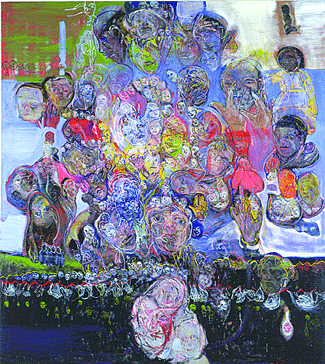Accumulation, decay, death, and renewal
The current exhibition at Betty Cuningham Gallery by painter Judy Glantzman pairs recent large-scale canvases with an array of small, hand-modeled figurines from 1996. Well-known for her enigmatic figure paintings, Glantzman’s beautiful, tough new works are built up through layer upon layer of probing attention. One can easily imagine the artist in her studio, ruthlessly painting over and then uncovering passages, as the evidence of her process mounts and eventually covers every square inch of the picture.
Glantzman’s distinctive palette and paint handling are what make the first impression. Deep blacks and reds, dirty greens, and whites are set off by strokes of robin’s egg blue, coral, and cadmium yellow. Marks is tenderly drawn, dryly scrubbed, or laid bare with thin rivulets of turpentine. Her gnarly surfaces are so manhandled that in some works the paint looks almost wooly and tapestry-like as it lays over the pentimenti of earlier decisions. Glantzman’s merger of idiosyncratic drawing, rich color, and highly tactile surface links her to a whole assortment of dreamy painters from Odile Redon and James Ensor, to Amy Sillman and Irving Petlin—who currently has a stunning show upstairs at Kent Gallery.
Most of the paintings appear to have begun as landscapes and bear the remnants of blue-green horizontal striations across their width. In “Bird in the Hand”—one of the few titled pictures in the exhibition—Glantzman plays with this reference as a swirling profusion of heads rises out of the black ground like an enormous cloud or blossom against a bright blue sky. In other canvases, the repeated oval heads are used almost as rubber stamps to create cruciforms, totems, mandalas, and other hierarchical compositions. Tiny red faces dangle from long strings like ripe cherries or the human skulls that adorn the belt of the fearsome Hindu goddess, Kali.
Gone are the uncanny, articulated full-body images of Glantzman’s earlier paintings and drawings. In their stead, accumulations of disembodied heads pile up in each canvas with an occasional hand or foot sticking out for good measure. Faces are drawn with varying degrees of specificity depending on their size—from the very detailed and individuated to the barely suggested and grotesque—resulting in a literal sea of humanity, which constantly shifts in and out of focus as your eye travels across the painting. Are we dancing wildly at Mardi Gras or feeling our way through the Paris Catacombs? Here and there a seductive eye emerges to lock with our own.
There’s something both ecstatic and funereal about the sense of anonymity created by Glantzman’s writhing masses that brings to mind the philosopher Mikhail Batkhin’s linkage of carnival and collectivity. Like Batkhin, Glantzman’s paintings ask us to partake in a communal ritual that heightens our awareness of the bodily and sensual commonalities between us. In Glantzman’s magnificent excess, we find a glorious paean to the continual cycle of death and renewal.
gaycitynews.com
































